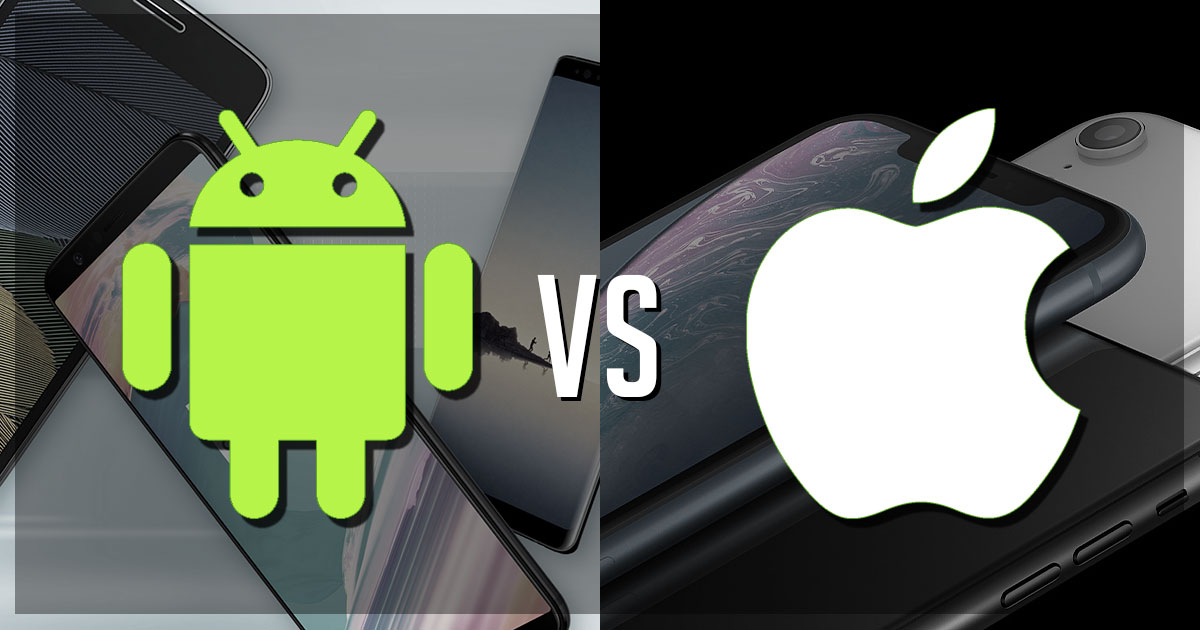Beyond a trivial comparison of similar feature sets, recent years have seen the iOS versus Android debate escalate into a cultural phenomenon of sorts.
Users associate with either platform on a personal level and often equate the type of phones they use with their perceptions of who they are as individuals.
“I’m on iOS because I don’t have time to sweat the small stuff.”
“I’m on Android because I know value when I see it.”
The main reason why the argument itself is so heated? Both iOS and Android are amazing at what they do, but not without obvious drawbacks.
iPhone users claim the corner of ease-of-use and seamless functionality, while Android aficionados ruthlessly berate the opposition for allowing themselves to be held back on an at-times outdated system with hardware that always comes at premium.
But for those jaded by the unrelenting squabbling, continue reading if you’re in the market for a new phone and can’t make up your mind over which system to go with. There are enough differences between the two operating systems, and you can bet that one will suit you more than the other.
Note: If you’re too lazy to read the whole article, skip to the end for a table summary of which operating system is the right one for you.
iOS
The Forbidden Fruit
If you surf the web, you’ll know well enough that there’s no shortage of criticism leveled at Apple and their “expensive” devices.
The latest line-up of iPhones released at prices that can only be described as extortionate—RM3,599 for the cheapest iPhone XR and a base price of RM5,399 for the class-topping iPhone XS Max.
But inside the premium-costing enclosure of an iPhone is an operating system that has proven itself reliable time and time again.
For one, the much vaunted idea that the iPhone “just works” holds plenty of merit. Apple’s tightly integrated ecosystem of devices and software is just easy to get into and use.
Due to the framework of iOS being custom-fitted to each Apple device as opposed to Android’s one-size-fits-all nature, it’s rare to encounter compatibility problems with third-party apps from the App Store, and there are less slow-downs while navigating through menus.
With a tightly integrated system also comes a host of other benefits including: hardware longevity (even with smaller batteries, iPhones have been known to last for periods comparable to other Android devices with bigger power reserves), fewer bugs, timelier over-the-air updates, a larger selection of quality apps from the App Store, and fuss-free connectivity with other Apple devices in the ecosystem, like the Apple Watch or Apple TV.
One Bad Apple
On the flip side, there’s also a fair bit to lament with iOS. The chief complaint is, again, the exorbitant prices of the devices it ships with. While the very nature of Apple’s closed ecosystem can ensure a smoother, more consistent, and more secure experience from user-to-user, the high price it can cost often warrants the buyer a rethink before committing.
Simply put, where the purchase of an iOS smartphone is concerned, there will always exist a trade-off of some sort: to get the full complement of features and top-end usability, you either cough up the asking price for the latest device, or settle for a previous generation one that most probably lacks that cutting edge new feature or new processor.
Beyond price, there’s also the slowness on Apple’s part to innovate on features over recent times. Where they used to represent constant innovation, Apple’s more recent offerings, especially iPhones, have lagged behind their Android counterparts in both software and hardware.

Be it the lack of customisability to the home screen, the late addition of quick-charging, or even first-party software products such as Siri or Apple Maps that have proven to be second-best to Google’s offerings, there are many aspects of iOS that were once game-changers but are now playing catch-up.
TL;DR: Apple’s ecosystem of software and hardware sees almost everything work properly at the first attempt. If you’re in for a device that’ll serve you fuss-free right out of the box, this is probably the way to go—that is if you’re willing to put up with extremely high prices or sacrifice the latest features that usually come standard with Android devices.
Android
A Helluva Machine
Starting with the lowest hanging fruit, the foremost reason to pick an Android device over an iOS one is all about price. With devices ranging from the mid hundreds all the way to five grand, anyone in the market for a new phone will be able to find an Android at a price point to fit their budget.
There’s a reason why the top two smartphone makers in the world (in terms of sales) are now both on the Android platforms (Huawei surged ahead of Apple in Q2 this year).
Yes, while not all Android devices provide the best value for what you pay (and I’ll get to that in a bit), there are a number of standout devices at each price level that prove you can drop less than a fortune on a phone and still receive tremendous value.
Xiaomi’s Pocophone F1 will cost you just above RM1,200 and offers ridiculous bang-for-buck. Past the RM2,000 mark, the OnePlus 6 still reproduces some of the fastest speeds you’ll find in a 2018 smartphone. If it’s cutting-edge you seek, just look over at Samsung’s Note 9 and you’ll be hard-pressed to find another device with such a complete and class-leading skill set.

Beyond the price issue, there’s also a lot to note about how far Google’s smartphone operating system has come since it launched circa the end of the 2000s. Comparing the Android 2.2 Froyo device I owned back in 2011 to the various Androids I’ve tested this year alone, the difference is staggering.
Where there was once a bug and error-riddled system, there’s now an intuitive interface that’s often first at introducing new and innovative features that quickly become gold standards—the way it handles notifications for example, had been the envy of iOS users for ages until Apple introduced a similar management style with this year’s iOS12.
There’s also the high level of customisability and the ability to make an Android device into just about anything you want it to be—even an iPhone, on the surface level at least.
With custom launchers, widgets, and various other options to change how your phone looks and functions, jumping on the Android wagon is a no-brainer for the user looking to wield more control over the everyday experience of their smartphone.
“These Aren’t The Droids You’re Looking For…”
But going the other way and looking at the reasons not to tread down the Android path, the situation is pretty much the opposite of Apple’s strengths—where Apple does so well in maintaining a highly integrated hardware-software relationship, Android falters due to the fragmented nature of the devices it runs on.
The number of Android phone manufacturers worldwide was numbered at 1,290 in 2015, with 24,000 distinct devices. There are probably many more now.
What all this translates to is a situation where apps work well on some phones but perform horribly on others due to having different screen sizes, processing power, and different versions of Android loaded up.
Another thing that’s to be expected due to this fragmented nature is the slowness of system updates.
For example, Samsung—despite their amazing hardware and features—is famously slow to implement the latest Android updates, and generally, many other manufacturers on the Android platform also take months to release the latest versions of Android to their own devices.
TL;DR: While not as cohesive and tightly knit, Android provides a level of freedom and customisability. Plus, high-end Android devices are now being launched with features that iOS users won’t be able to enjoy until the next year at the very least. Most of these high-end Androids also come at prices that are significantly more value for what you pay.
-//-
|
iOS |
Android |
| Users who want their phone working flawlessly right away. | Those who want to tinker with all the settings and customise their devices to work exactly how they want. |
| Those willing to pay the high asking price, or are willing to settle for previous-gen devices by paying a bit less. | Anyone looking for value at any given price point. |
| Those who want a wider variety of quality and more secure apps. | Those who want the best hardware specs and latest features. |
| Those already entrenched within the Apple ecosystem. | Avid users of Google’s suite of productivity and lifestyle tools. |
| Users who prefer sticking with a long-lived device for years. | Anyone wanting the freedom to transfer data and files between different devices without the need for a proprietary programme or proprietary hardware. |
Feature Image Credit: Greenbot, Apple, and Android









